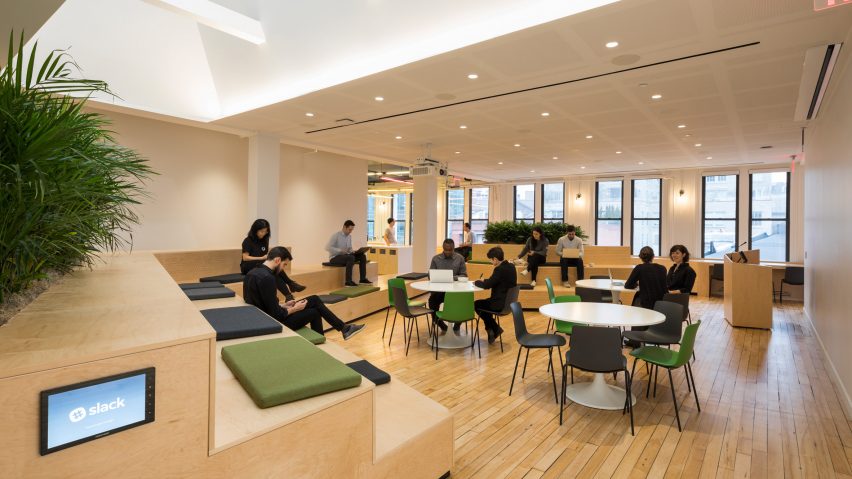Wooden bleachers and planted screens are intended to evoke New York City's urban courtyards at this headquarters for workplace messaging system Slack, by architecture firm Snøhetta.
The 12,000-square-foot space at the top of an 1880s landmarked building in the East Village was retrofitted for Slack, which offers messaging software designed to improve communication between team members and remote workers.
"Building on Slack's aspirations to revolutionise the virtual workplace, the design of its new physical work space promotes the same values," said Snøhetta, which has offices in New York and Oslo.
"From carefully managed acoustics and plentiful natural light in the workspaces to pockets for informal gatherings and lush, indoor courtyards, Snøhetta's design allows a variety of social interactions and work styles to flourish."
Ceilings around four existing skylights are angled to allow more light to enter the spaces.
Beneath these roof windows are pockets of space to be used like courtyards, for gathering and socialising.
The team used a material palette they describe as "evocative of an artist's studio", with the light tones of wood interrupted by splashes of colour across the meeting rooms.
Planters filled with bamboo create screens in front of glass-walled rooms, and sit in front of blank surfaces to add greenery.
At the heart of the office, informal conversations and large presentations can take place on large plywood steps that form bleacher-style seating – a favourite in tech offices.
Similar set ups can be found in the workplaces of Evernote, Fairphone and Airbnb.
But unlike the offices of Google and Microsoft, filled with games and slides, Slack's space is pared back to encourage employees to venture outside during their breaks.
The majority of the workspaces are open plan, but one- or two-person booths offer more privacy.
Fabric panels inside these small rooms aid the acoustics, while meeting rooms are laid out asymmetrically for the same reason.
Snøhetta has recently completed a couple of landmark projects: King Abdulaziz Center for World Culture in Saudi Arabia and the extension to SFMOMA.
Smaller works finished by the firm over the past few months include a charred-timber treetop cabin for Sweden's Treehotel and a crinkled stainless-steel addition to 1960s museum in Norway.
Photography is by Michael Grimm.

